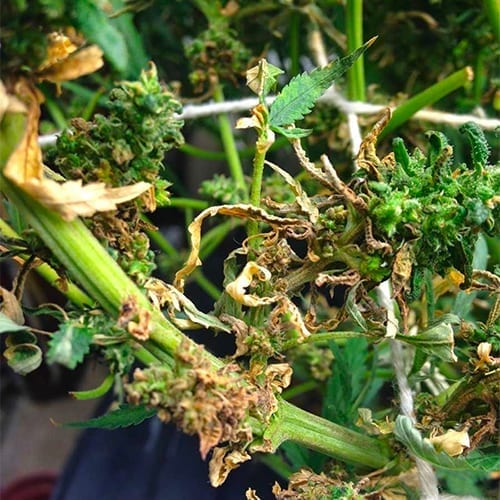
What is Root rot?
Root rot is a disease that affects many types of plants, including cannabis. It can be caused by different agents like Fusarium, Pythium or Rhizoctonia, which is a genus of fungi named by Augustin Pyramus de Candolle to describe a group of organisms in the order Cantharellales which don’t produce spores but hyphae and sclerotia. Rhizoctonia means “root killer”.
These organisms are able to survive in the topsoil (and also in plant debris) for long periods of time, causing damage to many types of plants, of course also to marijuana plants. Thus, they don’t need host plants to survive, and can attack plants in their surroundings as long as temperature and humidity conditions inside the grow tent – or outdoors – are suitable for their propagation.
Development of root rot
A number of factors can cause the development of this disease: temperatures ranging between 15 and 24ºC (being spring and autumn seasons the most suitable seasons), a soil too wet or too hot, without sufficient drainage or an excessive use of nutrients for cannabisrich in nitrogen also favor its appearance.
Fusarium can attack our plants if the temperature of the growing media (20-34ºC) or the nutrient solution (more than 24ºC) are too high, especially if we are using soil with high content of potassium and low content of nitrogen. Bare in mind that Fusarium spores can remain in dead plant matter for 6 years, so removing any plant debris from the growing space is crucial.
Pythium produces spores that also remain in dead plant material for long periods of time until they find a live host plant. Once they reach the roots of the plant the spores germinate and form the mycelium, which will soon cause root and stem rot.
Rhizoctonia are saprotrophic fungi that can infect a vast number of plant species. Among many others, this group of fungi can cause different diseases on plenty of plants, like root rot, damping off, black scurf, brown patch,…
Symptoms and damages caused by root rot
At first,the growth of the upper part of the plant is notably slowed. The leaves turn yellow and develop chlorosis to finally die. The overall state of the plant is rapidly deteriorated, from the initial wilt to the development of brown spots on the leaves and stems (even the buds or fruits) which will soon die.
Under the soil surface, it’s possible to observe necrosis of the root hairs, which gradually stop absorbing water and nutrients (which causes the aforementioned symptoms of chlorosis). The roots develop brown tones with necrotic tips. The stem base can also show dark or brown staining.
Basically, what we see is a general wilting of the plant, especially during the hottest hours of the day. We will also see that the plant does not recover from that wilting, no matter how much we water it; in this case, many growers could think that the plant needs more water, which far from solving the problem further aggravates it. Plants usually die a week after the first symptoms are shown.
Curing – or even just trying to manage – an infection of any of these fungi is almost impossible. Keeping this in mind, the only thing we can do is to prevent its appearance in our crops: How? Follow these easy steps to highly reduce the chances of infection:
- Use a Substrate suitable for cannabis with good drainage and which doesn’t retain too much moisture.
- Don’t water too much and avoid to swamp the substrate.
- Don’t water with hot water or during the hottest hours of the day.
- Don’t over-fertilize the substrate (especially with nitrogen).
- Whether you use seeds or cuttings, remember that proper hygiene is crucial. Disinfect your utensils and tools before use.
- Use beneficial fungi and Microbial life for the roots – Trichoderma – which will protect the root system of your plants.
- Always discard the substrate attacked by fungi.
- Keep your grow space clean and free from plant debris.
- Avoid high soil temperatures.
- Grow in raised beds and disinfect the pots thoroughly, especially if you are using clones or plants with wounded stems.
Source: www.alchimiaweb.com





